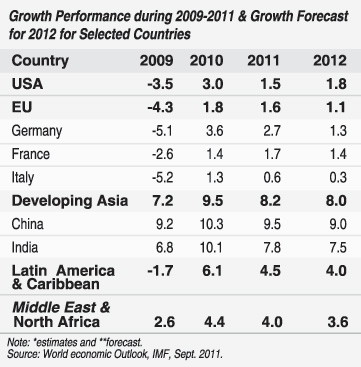The Global economy is going through turbulent times. The Business Times spoke to Dr. Saman Kelegama, Executive Director, Institute of Policy Studies of Sri Lanka, on the current global economic situation, lessons from 2011 and the prospects and challenges for developing countries and Sri Lanka in 2012.
How do you see the 2011/12 crisis with that of the 2008/09 crisis?The core of the 2008/09 crisis was driven by bad banking assets and sophisticated mortgage securities in the developed countries, mainly USA, while the core of the 2011/12 crisis is driven by sovereign debt problems, mainly in European countries.
The main difference can be seen in the policy responses to the crisis in the two periods. In 2008/09, governments had enough policy space and responded either by a fiscal stimulus or monetary relaxation by reducing the interest rates. In 2011/12, Western governments have run out of policy space -- public debt and fiscal deficits are very high and hence there is no room for fiscal stimulus; interest rates are near-zero and there is no room for further reduction. So the global markets are well aware that the policy firepower is muted to react to the current crisis. What is worrying is that fiscal austerity is now pursued to its limits in Europe at a time when credit markets are freezing – this is a recipe for economic stagnation like what Japan experienced in the 1990s. IMF Chief, Christine Lagarde had stated recently that the global economy is in danger.
What are the lessons from the 2011 global economic performance?There are a number of lessons that we can learn from the 2011 country/region economic performance.
First, monetary easing takes a long time to revive an economy unlike a fiscal stimulus because the former is heavily dependent on private sector sentiments. Most European countries have run out of fiscal space due to excessive debt and the only option they have is monetary relaxation, which they have put into operation at present, but it is not producing the desired growth revival. What is required is to work out policies that would promote both growth recoveries in the short-term and sufficient debt reduction in the medium term. This would require a credible debt reduction plan (with the European Central Bank involvement) that would take care of major budgetary areas and allow for some spending in the short-term. Without such a combination of policies, a mix of growth reduction and debt reduction will not be sufficient to reduce debt to GDP significantly in the medium term, resulting in public protest against self-defeating austerity measures.
Second, the EU experience shows that a Monetary Union with single currency and a European Central Bank (ECB) cannot be fully effective without fiscal harmonization among member countries. EU embarked on a Monetary Union without fiscal harmonization. Fiscal Harmonization will be easy if there is a Political Union, like a United States of Europe, which will be a long shot given the cultural and historical differences among European countries. At one time, the debate in EU focused on affected countries like Greece, Ireland, Portugal, Italy, and Spain leaving the Monetary Union but this would have triggered a collapse of the entire EU, so now the debate is on how the ECB could play a role to rescue the affected countries and bring some degree of fiscal harmonization to move forward. In sum, the lesson is that fiscal harmonization is essential for a Monetary Union to be effective. (The recent German initiative for an EU Treaty change to bring fiscal harmonization was however vetoed by UK).
Third, the debt roll over strategy (borrowing to repay maturing debt) has its limits as the Greece experience clearly shows. Debt roll over strategy works to some extent and one can assume that more revenue will be available to settle maturing debt in the medium term but there comes a time when the strategy does not work. This happened in Argentina in 2002. Only an international bail-out will work at such times, and today Greece and other affected countries in EU are just waiting for such a package.
nWe saw the second dip in the global economy in 2011 and this was reflected in the lower growth in 2011 compared to 2010; will the situation continue in 2012 ?
After the 3rd quarter of 2010, the growth momentum generated by the fiscal stimulus in most developed and developing countries (as a reaction to the 2008/2009 crisis) ran out and what we saw since then was a slowing down of the growth in many countries, especially the EU and US. Most Asian countries in the epicentre of modern global growth, also showed an economic slowdown and this was reflected in the overall growth rates for 2011 (see Table 1).
The EU and USA have run out of policy space to stimulate their economies as explained earlier. The US has space for non-conventional monetary policy in the form of quantitative easing at a time when interest rates are near-zero but whether this option wil be used in 2012 is yet to be seen.
Due to inflationary pressure, both China and India moved away from monetary relaxation to monetary tightening in mid-2011 in order to reduce domestic demand generated by large domestic investment and consumption. China has managed to bring inflation under control and avoided a hard-landing and has once again started to relax monetary policy but India has jacked up its interest rates to take excessive pressure out of the exchange rate to depreciate and control domestic demand. The Indian currency has depreciated by about 20% vis-à-vis the US dollar since the middle of 2011. This pressure is due to the expanding trade deficit in India.
Growth for 2012 has been revised down for most countries as shown in Table 1 (US growth has been upgraded from 1.1% in 2012 to 1.8% recently). Growth has been revised downwards for a number of Asian countries – in addition to China and India that are shown in the Table, Hong Kong from 5.0% in 2011 to 4.3% in 2012, Korea from 3.9% to 3.5%, UAE from 3.9% to 3.1%, etc. So to answer the question, the situation will continue in 2012 and growth will be lower than in 2011.
 What about the behaviour of the global commodity prices in 2012?
What about the behaviour of the global commodity prices in 2012?A: According to the World Economic Outlook of the IMF (September 2011 issue), global oil prices are to decline by 3.1% and Non-Oil commodities prices are to decline by 4.7% in 2012. But after closely examining the commodity price behaviour in 2011, it can be said that the global commodity prices will be volatile as in 2012 due to a number of factors influencing the prices: supply disruptions given the climate conditions, slowing global growth reducing demand for commodities, interaction of food and oil through biofuels, and speculation in commodity markets.
During 2003-2010, assets allocated to commodity index trading have risen from US$ 13 billion to US$ 320 billion and the number of outstanding contracts on commodity futures and options have risen from 13 million to 66 million. This has disrupted the traditional trading relationship between future prices and supplies. Financialization of commodity markets is a major concern for developing countries. The recent fall in some commodity prices like oil without any fundamental change in demand and supply forces in the short-term, brings into focus the impact of speculating investments in commodity markets, which is a significant force to reckon with.
If there is going to be a third round of Quantitative Easing (QE) in the USA, like during the last two rounds of QE, more capital is going to flow in search of higher returns in bonds, other assets, and commodity markets. Such investment in commodity markets will contribute to food price escalations. In short, global commodity markets will be volatile with a trend downwards in 2012 but will escalate if the 3rd QE is initiated in the US.
What are the pressures from the global economy for developing countries in 2012?There are forces at work that are exerting pressure for currency depreciation in 2012 unlike in 2011/2010, where there were pressures for currency appreciation. As seen in previous global downturns, there is a tendency to protect domestic industries in affected economies by restricting competition from exports. This can lead to depreciation of currencies of developed countries and trade measures aimed at supporting exports while restricting imports. As a result, there is a possibility of competitive depreciation of currency in developing countries in order to maintain export competitiveness.
Second, at a time of perceived global economic uncertainty, the region is also affected by the standard reaction of a “flight to safety” – a retreat of assets to a destination perceived to be safe. So, despite concerns of sovereign debt in US, investors have once again retreated to US Treasury Bills in large numbers. Asset markets will be somewhat destabilized by sharp outflows of capital and capital outflow from developing countries is exerting pressure on currency to depreciate.
Third, in some developing countries, due to growing trade deficits (current account deficits) with imports far outweighing exports, there is pressure on the exchange rate to depreciate and curb imports while incentivizing exports.
What are the prospects for the Sri Lankan economy in 2012 ?According to available statistics, Sri Lanka grew at 7.9% in the first quarter (QR), 8.2% in the 2nd QR and 8.4% in the 3rd QR of 2011. In the third QR, construction has grown at 17.3%, industry at 10.8%, services at 7.8%, and agriculture at 6.2%. Industrial growth has been supported by mining and minerals growing at 19.6%, services by hotels/restaurants growing at 27.2%, and agriculture by paddy growing at 12.4% growth.
Exports have shown a growth rate of 23.4% in the first 10 months of 2011. Tourist earnings will be close to US $ 800 million, FDI will be around US $ 1 billion, and remittances around US$ 5 billion by the end of 2011 –all three items, highest recorded in the country. Recent off-shore gas discoveries also augur well for the economy.
Construction growth is basically triggered by the massive infrastructure programme led by the average 6% GDP capital expenditure of the government with contributions from the private sector. Tourism (plus hotel sector) growth was expected after the North/East war came to an end, and remittances have been a great source of strength to the Sri Lankan economy, now being the highest foreign exchange earner. There are reasons to believe that these growth generators, in particular, construction activities and remittances, will play a similar role in 2012 but there are concerns on tourism. Close to 40% of tourist arrivals are from Western Europe, and given the current economic downturn in Europe, there can be a decline of tourist arrivals from this region.
However, if this decline is compensated by more tourist arrivals from the Asian region, then the momentum of increased tourist arrivals could be maintained. There are however issues on the macro-economy. Our export growth is below that of countries like India (52.1% export growth) and the import growth at 50.7% in the first 10 months of 2011 far outweighed the export performance. Due to the ever increasing current account deficit in the balance of payments (imports almost double that of exports), there will be pressure on the exchange rate to depreciate. The current strategy of using the foreign reserves for defending the currency has its limitations and there will be no option but to allow the interest rates to go up so that it becomes a supporting anchor for the current exchange rate regime. The ‘trillemma’ or the ‘impossible trinity’ is well known -- where it is impossible to have a partially open capital account with an exchange rate peg and a stable interest rate. One has to give way, to be in line with the global and domestic market forces.
Since the exchange rate was defended before the 3% devaluation in mid-November and again defended after the devaluation using the foreign exchange reserves, overall amounting to above US $ 1 billion in 2011, there is pressure on the interest rates to go up to reduce domestic demand and cut imports. This we have already seen in the market, giving ample evidence to the “trilemma” explained earlier. The simple truth is that we cannot defeat the market and swim against the tide.
Unlike a depreciation of currency, an increase in interest rates will make inroads to the growth process and slow down the overall growth. That is why most governments allow the depreciation of currency, as India has done with a 20% depreciation during the last 6 months, to bring about a sharing between interest rate hike and currency fall to avoid excessive pressure on either instrument. An increase in interest rate will reduce demand for credit and also attract more deposits to banks and improve the liquidity in the banking system. However, interest rate hikes will not be very favourable for a stock market boom. Moreover, exports will slow down in 2012 as Sri Lanka’s major markets, viz., US and EU (accounting for 56% of exports) will manifest a reduction in demand. We will witness these dimensions in the Sri Lankan economy in 2012. Thus, the overall growth in 2012 will be lower than 2011 and will be in the range of 7 to 8 per cent.
What is the worst case scenario for developing countries like Sri Lanka you see for 2012?The worst case scenario will result if: (a) the European Union breaks up, and (b) US will engage in a third round of quantitative easing. Let me elaborate.
First, if the EU breaks up, a rapid bank run is likely with individuals and institutions withdrawing their deposits out of the affected economies like Greece, Italy, etc. The banking and financial system in EU will be threatened and will spread to US and there will be a credit crunch. Equity markets will also collapse in EU and US and spill over to the developing economies via contagion effect. The new currencies that EU countries will create will depreciate dramatically against well established global currencies such as dollar, Yen. RNB, etc., and will further reduce demand for exports from developing economies like Sri Lanka.
Second, is the further loosening of monetary policy in order to give another round of stimulus to the US economy. Of course, given the near-zero interest rates in the US it is not possible to further reduce the policy rate (guiding interest rate). Thus, the non-conventional approach of relaxing monetary policy in the form of quantitative easing – as used twice before can be used.
The previous two rounds were not very effective and there are doubts as to whether another round will bring a turnaround to the US economy. But given the fact that there is no policy space for a fiscal stimulus and President Obama has to face the polls in November 2012, there is a possibility that he will have another go at a QE policy assuming that it might work this time. If this takes place, it would introduce huge liquidity into the global financial markets which will go in search of speculative investment, among others, in food and the oil market and will insert pressure for price hikes in these two essential commodities. With currency already under pressure for depreciation in most developing countries, such increase in global commodity prices will manifest as huge price increases in developing countries bringing severe hardship to the poor people living in those countries.
http://sundaytimes.lk/120101/BusinessTimes/bt08.html
 would enable you to enjoy an array of other services such as Member Rankings, User Groups, Own Posts & Profile, Exclusive Research, Live Chat Box etc..
would enable you to enjoy an array of other services such as Member Rankings, User Groups, Own Posts & Profile, Exclusive Research, Live Chat Box etc.. 
 Home
Home



















